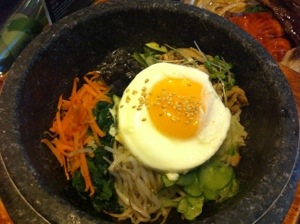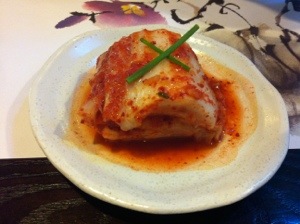 I always thought the Erasure song was written about the city in Korea … apparently not. It’s what I always think of when I hear the song or think of Korea anyway, despite never having been to Korea and to be honest not really knowing where it is on a map, as I am utterly useless at geography.
I always thought the Erasure song was written about the city in Korea … apparently not. It’s what I always think of when I hear the song or think of Korea anyway, despite never having been to Korea and to be honest not really knowing where it is on a map, as I am utterly useless at geography.
One truth I have recently discovered, however, is that Korean food is damned tasty. I discovered this at Kimchee restaurant in Holborn, which may not be the most authentic place for Korean food, but it is certainly a good entry point. I went with my friend Rachel and ordered lots of food which I didn’t recognise but was all delicious.
What wasn’t on the menu (which I am pleased about as the idea makes me feel slightly sick) was “shit pig”. Now, I don’t know if that’s the official name, but pig which has been fed human excrement is apparently a real delicacy in Korea, so it is an appropriate name at least. I have been told by real people (not just web page anecdotes) that it’s some of the best meat they have ever eaten. I’ll pass, thanks.
 Instead, I will most certainly be eating again the fabulous Bibimbap. I had the chicken version at Kimchee – it’s basically stir-fried rice cooked in a heavy and hot stone pot so that at the bottom the rice goes all crusty and crunchy; and the vegetables, meat and egg laying on the top of the dish get stirred into the rice once it comes to the table and you end up with a delicious mixture of all the different ingredients and textures. I adored it, and couldn’t hoover up the food quickly enough with my ineptly-held chopsticks (potential new diet option there: use chopsticks to eat everything because it’s hard to pick up a big portion of food and you therefore eat more slowly …).
Instead, I will most certainly be eating again the fabulous Bibimbap. I had the chicken version at Kimchee – it’s basically stir-fried rice cooked in a heavy and hot stone pot so that at the bottom the rice goes all crusty and crunchy; and the vegetables, meat and egg laying on the top of the dish get stirred into the rice once it comes to the table and you end up with a delicious mixture of all the different ingredients and textures. I adored it, and couldn’t hoover up the food quickly enough with my ineptly-held chopsticks (potential new diet option there: use chopsticks to eat everything because it’s hard to pick up a big portion of food and you therefore eat more slowly …).
We also had kimchee (pickled cabbage), pork balls in a rice paper basket, summer rolls, salmon in a beautifully flavoursome sauce, and squid in chilli sauce. All delicious and served as soon as it is cooked, so it’s better to be sharing as chances are your dishes won’t all arrive at the same time.
 In fact, Kimchee reminded me of Wagamamas in that you sit at communal benches and service is quick and efficient and food comes when cooked, not according to whether it is a starter or main course. It’s not the place I would choose for a romantic evening (like the couple who were sat next to us, where the guy was clearly feeling very awkward after presenting a rose to his beloved and then having Rachel and me to turn up and share their table, somewhat spoiling the moment!), but it’s perfect for a fun dinner with a few friends. We drank soft drinks and didn’t bother with any dessert except green tea, and the bill came in at around £20 each, which I felt was excellent value for money.
In fact, Kimchee reminded me of Wagamamas in that you sit at communal benches and service is quick and efficient and food comes when cooked, not according to whether it is a starter or main course. It’s not the place I would choose for a romantic evening (like the couple who were sat next to us, where the guy was clearly feeling very awkward after presenting a rose to his beloved and then having Rachel and me to turn up and share their table, somewhat spoiling the moment!), but it’s perfect for a fun dinner with a few friends. We drank soft drinks and didn’t bother with any dessert except green tea, and the bill came in at around £20 each, which I felt was excellent value for money.
A few days afterwards I was watching Jamie Oliver’s latest TV show about money-saving cookery ideas, and he made a version of Bibimbap with leftover beef. He demonstrated some good ideas and so I created my own Bibimbap which is partly based on his recipe, and partly based on a variety of online recipes I have discovered. The result is probably highly inauthentic but nevertheless delicious, and I will definitely be making it again.
 Tracy’s ‘Korean’ Bibimbap – serves 4
Tracy’s ‘Korean’ Bibimbap – serves 4
For the bbq chicken (dak bulgogi): 3 chicken breasts, 1 sliced onion, 2 chopped spring onions, 1 teaspoon of lazy garlic, 1 teaspoon of lazy ginger, half a teaspoon of dried chilli flakes, 5 tablespoons of soy sauce, 1 teaspoon of brown sugar, 1 tablespoon of sesame seeds
For the Bimimbap: 1 quantity of bbq chicken, a splash of vegetable oil, 180g cooked brown rice, 1 chopped onion, 1 teaspoon of lazy garlic, 1 chopped chilli, 1 large carrot grated, a couple of handfuls of fresh spinach, 1 poached egg per person
To make the chicken bbq: thinly slice the chicken and then marinate it in a sandwich bag with all the other ingredients for at least one hour. Then barbecue the chicken, or – like me – fry it in a pan with a splash of oil and a sliced onion until cooked through (between 5-10 minutes depending on the thickness of the chicken). I made the chicken and boiled the rice on the same day so that I had a quick job of assembling the Bibimbap on day two.
To make the Bibimbap: heat the oil in a thick bottomed large frying pan and fry the onion, garlic and chilli. Once softened, wilt the spinach in the pan and add the rice. Stirfry it for a minute and then lower the heat and press the mixture down into the pan so that the rice can start to brown against the bottom of the pan. Add the chicken and grated carrot to the top of the dish and cover with some foil so that the meat can warm through. You could also add peppers and other veg at this stage.
Allow the dish to cook for around 10 minutes while you poach your eggs according to taste (runny yolks for me!). It’s hard to say for sure how long to cook the Bibimbap because you want the rice at the base of the pan to be brown and crispy, and I chickened out after 10 minutes as I didn’t want to burn the rice … it turned out it had started to go brown and crispy but only in places so when I stirred the dish together I only had a few crunchy bits mixed in. I probably should have used more oil in the bottom of the pan to fry the rice but I wanted the dish to be quite healthy as well – if you don’t have to make something so diet-friendly then add more oil to the pan at the start.
When you are ready to serve the dish, stir the Bibimbap around so that the crusty bits, veg and chicken are all well mixed and dish it up onto a plate. Place your poached egg on the top and serve with chilli sauce, soy sauce and gochujang dressing (which I didn’t have – it’s on my list for my next trip to the Asian supermarket!).
It tastes gorgeous and even more so the next day when the flavours have combined further. This and Hainanese chicken are probably our two current favourite meals. Somehow I don’t think shitty pig will be joining them!

[…] visiting restaurants to get ideas for my own dishes, such as my trip to Kimchee in Holborn to make Korean Bibimbap. I am sure I’ll have even more great experiences as I work through the alphabet for my […]